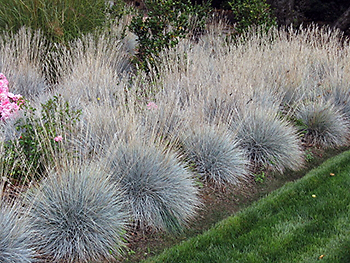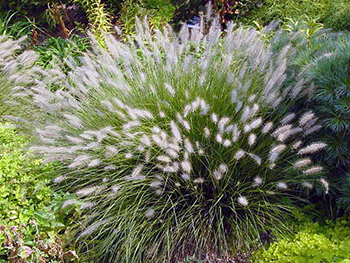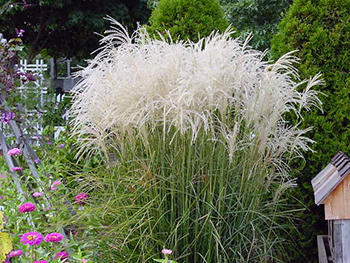Ornamental Grass Care
 Grasses have long been popular in the garden. They add a striking appearance with their upright habits and various textures. Plus, let’s not forget the winter interest. Grasses are, for the most part, easy care in the landscape as they are heat and drought tolerant, and pest free.
Grasses have long been popular in the garden. They add a striking appearance with their upright habits and various textures. Plus, let’s not forget the winter interest. Grasses are, for the most part, easy care in the landscape as they are heat and drought tolerant, and pest free.
Traditional ornamental grasses are non-native species like Miscanthus and Pennisetum. But now our local native grasses are finally making their way into the landscape. Big and little bluestem, switchgrass and prairie dropseed are just a few of the Flint Hills favorites that are garden worthy. Selective breeding has helped refine some of these natives so they now have more interesting aspects. These attributes include fall color, summer leaf interest and a more refined plant habit better suited for higher maintenance gardens.
The amount of grasses used in the landscape continues to increase. Traditionally, grasses have been used to provide interest in the mixed perennial garden. Gardens planted with large sweeps and drifts of grasses now dot the landscape. This is especially true when using our local natives. Native grasses sometimes look best and more natural when the prairie effect is recreated.
Maintenance of ornamental grasses
 One of the yearly chores in maintaining a grass garden is cutting the plants back. Each spring the old growth should be removed to make way for the new green growth. Cutting back large clumps of grasses is not always an easy task. Dry grass blades can be itchy and have razor-like edges.
One of the yearly chores in maintaining a grass garden is cutting the plants back. Each spring the old growth should be removed to make way for the new green growth. Cutting back large clumps of grasses is not always an easy task. Dry grass blades can be itchy and have razor-like edges.
PPE — personal protection equipment
When tackling a clump it is best to dress for the occasion. Long sleeves are a must to help get your arms around the clump. Tying up or pulling the old stalks together before attempting to cut them back will make the task easier and cleanup a breeze. Simple ways to contain the clump is to wrap the entire plant with a bungee cord, or, better yet, compostable twine. By securing all the stems together they won’t fall all over the place. The entire mass can then be properly disposed.
Cutting ornamental grasses made easy
 Cutting down the woody stems can be a difficult chore. Depending on the number and size of clumps, choose the proper tool. If you only have a small clump or two then hand shears may do the trick. Larger plantings of ornamental grasses call for bigger tools. These tools can range from a hand-pruning saw to a set of electric hedge trimmers. Why make the task more difficult when a power tool can do the trick. Spoken like a true man, more power is always good.
Cutting down the woody stems can be a difficult chore. Depending on the number and size of clumps, choose the proper tool. If you only have a small clump or two then hand shears may do the trick. Larger plantings of ornamental grasses call for bigger tools. These tools can range from a hand-pruning saw to a set of electric hedge trimmers. Why make the task more difficult when a power tool can do the trick. Spoken like a true man, more power is always good.
In addition to the recommended long sleeves it is also a good idea to arm yourself with a thick pair of leather gloves and proper eye protection. Grasses that are withering oftentimes have pieces that flake off which could become lodged in the eye. As they say, an ounce of prevention is worth a pound of cure.
Dividing overgrown clumps
Maybe the most difficult part of growing ornamental grasses is dividing the clumps when they become overgrown. There is no easy way to get a big old clump of grass out of the ground because the plants have a very tough root system. This is what makes them so heat and drought tolerant and good plants for the garden.
Dynamite may be needed for some overgrown clumps. All joking aside, the bottom line is it’s work, hard work, and there is no easy way to dig out and divide the plants. Like with cutting back, power tools may be a salvation. For those with a reciprocating saw, now is the time to break it out. Other ways to help excavate the clump is with a very sharp shovel or an axe.
The best advice is to not let the grass clumps get away from you. This is probably easier said than done. The tip here is to never let the clump get more than a foot in diameter. When the clump is this small it is much easier to work your way around the plant and then undercut and roll it out of the ground. This might mean the ornamental grass is divided every couple of years.
I realize some of you are thinking that this is no longer low maintenance but work. Unfortunately, grasses can get out of hand; clumps can reach three feet or more in diameter. If you are growing these plants in a grass-only planting this may work. But for those that include ornamental grasses in a mixed perennial garden as an accent plant, you will soon realize they have grown out of bounds and need to be divided.
One of our Extension Master Gardener demonstration gardens has a number of ornamental grasses. We utilize the practice of dividing every time the clump is a foot in diameter and it has worked. Just about anyone can tackle this size of plant. Unfortunately we have let a few get away from us, and let me tell you it is more and harder work than frequent dividing. The nice thing about these grasses is that, within a season, they are once again full size and in all their fall beauty.
Replant smaller divisions of ornamental grasses
Another point to consider when dividing is not to replant a large division. The reason is the larger the clump the sooner you will be back dividing. I know it is very tempting to replant a nice size clump, but keep in mind many of these are fairly aggressive growers. My recommendation is to only plant back a division of four or five inches in diameter. Even this small of a division will probably reach the twelve-inch size in a couple of years. Plant back a larger clump and division may become a yearly task.
Spare the fertilizer
Here is one last tip when working with ornamental grasses — avoid fertilization. Whether they are non-native or native, both types thrive in poorer soil conditions. Fertilization will only result in more rapid growth which will require you to divide again.
The ideal time to cut back and divide grasses is in the late winter or early spring. The majority of ornamental grasses popular in Kansas City gardens are warm season types. This means they will green up later in the spring.
The spring planting season is a good time to add more of these versatile plants to the garden. Local garden centers are carrying an even wider selection, especially our local natives. Be sure to include these plants in your garden, as they are sure to reward.

Have questions? The Garden Hotline is staffed by trained EMG volunteers and Extension staff who will assist you with questions.
Phone: (913) 715-7050
Email: garden.help@jocogov.org